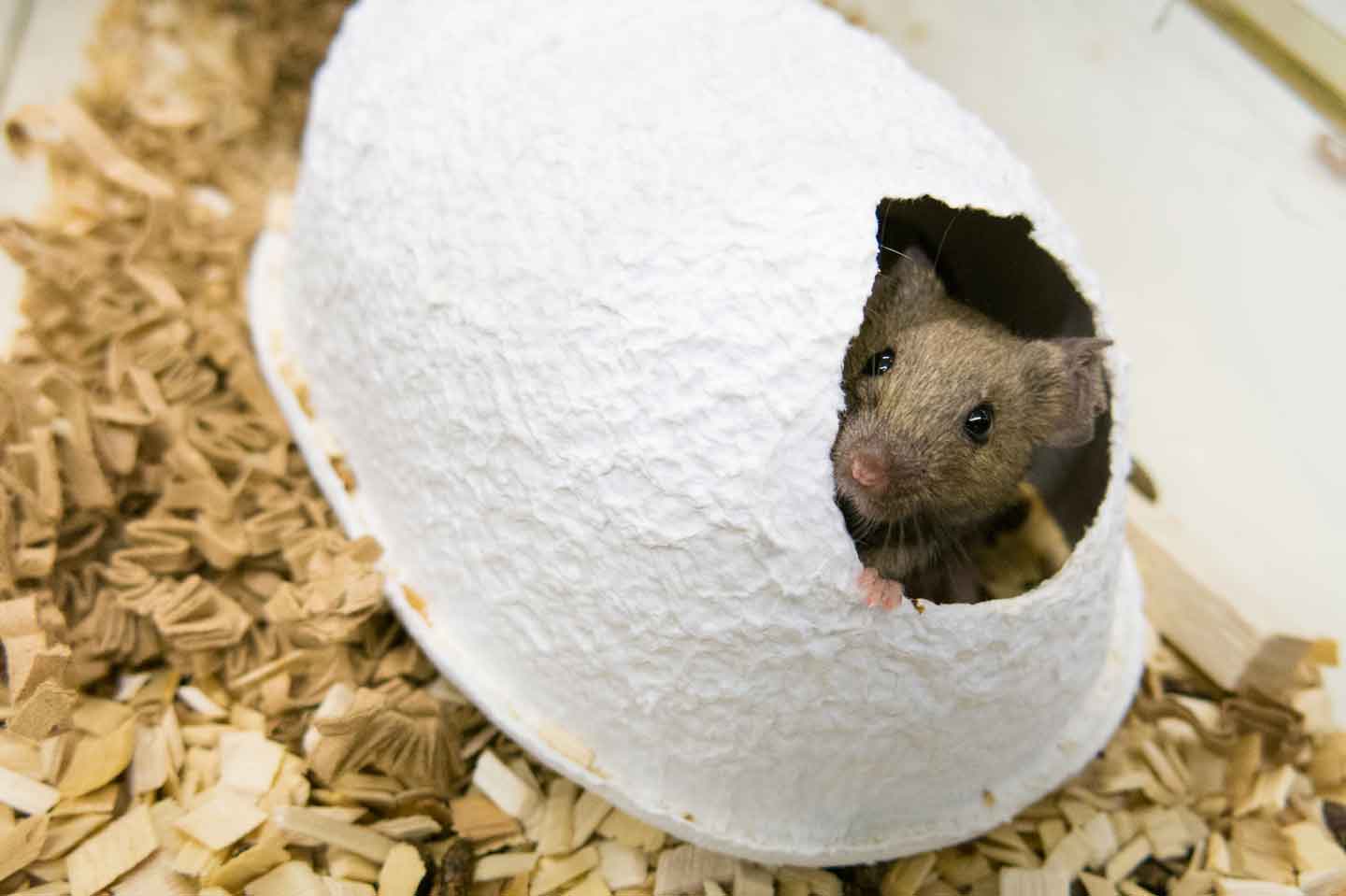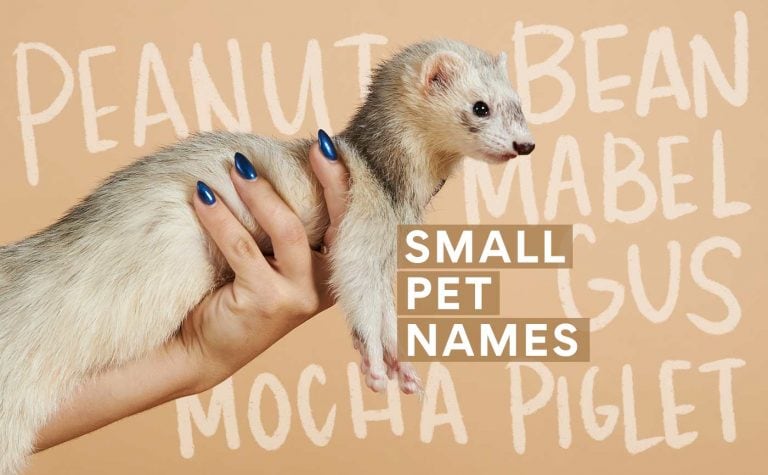Pet Mice: An Overview
- Scientific name: Mus musculus
- Range of sizes: 2.5 to 4 inches
- Life expectancy: 1 to 5 years
Fun Facts About Mice
- Mice don’t see as well as humans, but they excel in the smell, hearing, and touch departments.
- Their whiskers help detect textures and changes in the environment.
- Mice communicate with each other using ultrasonic vocalizations, which are sounds at frequencies higher than humans can hear.
- Mice are super adaptable creatures, thriving everywhere from barns to fields to your bedroom!
- This little creature is prolific when it comes to breeding. A single female mouse can give birth to 10 litters per year, with each litter containing three to 12 babies.
Supply Checklist
- Wire cage with a plastic bottom
- Absorbent bedding
- Hideouts and nesting material
- Toys, like exercise wheels, tunnels, and ladders
- Mild soap and water to clean the cage
- Rodent pellets
- Water bottle and/or shallow food dish
Mouse Cages

Follow this guidance to set up the perfect home for your new pet.
Enclosure
The best habitat for this domesticated form of the house mouse is a secure wire cage with a plastic bottom and multiple levels, says Carly Fox, DVM, a senior veterinarian at The Schwarzman Animal Medical Center (AMC) in New York City. Start with a spacious cage, offering about 18 by 20 inches of floor space to accommodate 2–3 mice.
She notes that the wire walls are important for ventilation, but you can alternatively opt for a glass or plastic option as long as it has excellent ventilation. The plastic bottom, on the other hand, is non-negotiable. It provides more comfort and helps prevent foot injuries compared to cages with wire flooring.
Mice are little escape artists, so Dr. Fox says you’ll want to make sure the mouse cage is secure to prevent your new pet from doing any unwanted wandering. Also, it’s best to keep your mouse cage out of direct sunlight and breezy areas to avoid significant temperature changes.
Bedding / Substrate
Provide at least 2–3 inches of soft, absorbent bedding such as undyed paper, Dr. Fox says. Avoid cedar or pine shavings, as well as sawdust, all of which can create respiratory distress or illness. Nesting materials like hay or shredded paper can be added atop the bedding.
She adds that there should be a secure place for sleeping—like a hideout box in the enclosure—filled with this bedding and nesting material.
Enrichment and Decor
Toys give your cute little furballs an opportunity to engage their minds and get some exercise. “Mice are very intelligent and like to play,” Dr. Fox says. “Putting in a solid exercise wheel, hammocks, and ladders will keep your mice entertained and happy.”
You can also incorporate fun hiding places—such as small houses; tunnels made from cardboard tubes; and hideouts—to promote feelings of security. Climbing structures like branches, ladders, and ropes satisfy their natural instincts, while chew toys or blocks help maintain dental health.
Friends
Mice should live in same-sex small groups since they’re very social animals, Dr. Fox says. Ideally, two female mice should be kept as pets. If two male mice are kept together and do not know each other, they will likely fight unless they are littermates and have been together since birth—and even then, they may fight once they mature. Also, it's generally not recommended to house a male and female mouse together unless you’re prepared for them to breed.
Cleaning and Upkeep
Clean your mouse cage regularly—ideally spot-cleaning daily, and doing a full clean two to three times per week—to prevent odor and to ensure a pleasant and hygienic environment for your little cutie. Cleaning involves changing out the bedding to remove droppings and urine. Place your mice in a temporary safe place, then dispose of old bedding, scrub the cage with mild soap, rinse thoroughly, and dry. Finally, add fresh bedding.
What Do Mice Eat?
A mouse diet consists primarily of specially formulated rodent pellets, says Dr. Fox. Some good examples include the Mazuri™ Mouse & Rat Food or Oxbow™ Garden Select Mouse & Young Rat Food. You can also offer fruits and vegetables—like tiny cuts of apples, bananas, peas, and carrots—in a separate bowl.
“Mice graze, so it’s good to provide their daily pellet needs at once and allow them to go to the bowl when they feel hungry,” Dr. Fox says. Discard any uneaten food pellets after 24 hours and any uneaten fresh food before it spoils or gets contaminated.
Harmful Foods for Mice
Avoid feeding mice the following foods, which can be toxic, poisonous, or otherwise harmful:
- Chocolate
- Citrus fruits
- Onions
- Garlic
- Raw beans
Also, steer clear of foods that have caffeine or are high in sugar, salt, or fat; these can cause health issues.
Handling a Mouse

Mice do not typically enjoy being handled unless they are trained to be held from a young age. They also have a tendency to bite when they feel threatened or scared, and their little teeth are pretty sharp. To avoid this, handling is best kept to a minimum.
“If you are interested in handling your mice more, you must train them to be comfortable around you,” Dr. Fox says. “You can talk quietly next to their cage, so they get used to your voice, and offer them a treat—like sunflower seeds—by hand to promote them coming up to you.”
If you do pick up your mouse, do not scruff them but instead gently scoop them up from underneath. Pay attention to your mouse’s body language. If they seem stressed, place them back in their cage.
Mouse Health
How can you tell if a mouse is healthy? Look for these signs:
- Clear, bright eyes
- Soft and smooth fur
- An active and curious personality
- Readily eating and drinking
- Maintaining their weight (no weight loss or gain)
- Regular grooming
- Clean ears and feet
Common Health Problems
Like any pet, mice can experience health issues. “Mice are prone to obesity, which is why regular exercise with toys and a wheel is recommended,” Dr. Fox says. “Mice are also prone to certain cancers, skin disease, respiratory disease, and diarrhea.”
When To See Your Vet
If you notice changes in your pet’s behavior, personality, eating, drinking, or elimination, take them to a vet specializing in mouse care. It's also recommended to take your pet mouse to the vet each year for a routine checkup. Regular veterinary visits can help detect health issues early on and keep your pet feeling great.
How To Find a Mouse Vet
To find a vet for your pet mouse, start by contacting local veterinary clinics and ask if they have experience with small rodents. You can also search online for local clinics that specialize in exotic or small animal care. Checking online reviews or asking other small pet parents for recommendations can be helpful too. Ensure your vet is knowledgeable about mouse health and behavior.
Choosing a Pet Mouse
Purchase your pet mouse from a breeder or reputable seller who properly socializes their mice, says Dr. Fox. Also make sure they are able to identify the mouse’s sex prior to them going home with you to prevent unwanted pregnancy and fighting. Additionally, look for a mouse that has a healthy coat, bright eyes, and good energy levels. If they show interest in interacting with you, that’s a sign of a good fit!
FAQs About Pet Mice
Q:Do mice make good pets?
A:Mice can make great pets. They are typically smart, active, and social animals. Plus, they are quiet, easy to care for—and don't require you to spend as much as you would on other types of pets like dogs or cats.
Q:Are pet mice sanitary?
A:Yes, pet mice are considered clean and sanitary. Since you have control over your pet mice’s environment and diet, this small rodent is not considered unsanitary in the same way their wild counterparts are.
Q:Do pet mice like to be held?
A:These small pets don’t inherently love being handled, but you can get them used to being held if you start doing so when they’re young. Always remain gentle, scoop them up from underneath, and try to keep handling to a minimum.
Q:How long do pet mice live?
A:When kept in captivity, they can live between one and five years.
Mice are wonderful pets who provide lots of entertainment and opportunities for meaningful bonding. Follow this pet care advice, and get ready for a squeak-tastic adventure with these miniature marvels who will steal your heart with their whisker-twitching cuteness!
What will you name your new mouse? Browse our list of small pet names for inspo.
Expert insight provided by Carly Fox, DVM, senior veterinarian at The Schwarzman Animal Medical Center (AMC) in New York City.
This content was medically reviewed by Chewy vets.
Share:

















